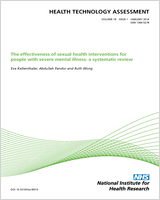Included under terms of UK Non-commercial Government License.
NCBI Bookshelf. A service of the National Library of Medicine, National Institutes of Health.
Pandor A, Thokala P, Gomersall T, et al. Home telemonitoring or structured telephone support programmes after recent discharge in patients with heart failure: systematic review and economic evaluation. Southampton (UK): NIHR Journals Library; 2013 Aug. (Health Technology Assessment, No. 17.32.)

Home telemonitoring or structured telephone support programmes after recent discharge in patients with heart failure: systematic review and economic evaluation.
Show detailsImplications for service provision
In general, although the effectiveness of the interventions varied widely according to the type of RM system used, STS HH and TM with medical support provided during office hours showed beneficial effects, particularly in reducing all-cause mortality for recently discharged patients with HF; however, these effects were statistically inconclusive.
Given the variation in usual care and RM strategies, the cost-effectiveness analysis was performed using a set of costing scenarios. These scenarios were designed to reflect the different configurations of usual care and RM interventions present in the UK. The cost-effectiveness analyses suggest that TM during office hours was an optimal strategy in most of the scenarios.
Suggested research priorities
Despite the growing evidence base for RM, a number of key questions are yet to be addressed. First, it would be helpful to have more direct comparisons of STS and TM. To our knowledge, only one study of recently discharged patients (TEN-HMS49) has made this comparison. The results of this trial suggested that TM was somewhat more beneficial than STS – in particular, TM had a substantially greater effect on reducing the duration of hospitalisation and the number of home or clinical visits. This broadly coheres with our findings (particularly from the sensitivity analyses excluding the Home-HF study67) that TM interventions showed a greater risk reduction than STS for mortality and hospitalisation. In addition, patients with HF are at increased risk of atrial fibrillation, which can lead to deterioration and hospitalisation. Further research on the precipitants of admission for HF (including atrial fibrillation, infection and non-compliance) and how they might be detected and managed early is required.
Given the complex nature of RM interventions, new research should seek to examine the ‘active ingredients’ of RM. For instance, the NMA was unable to compare the effectiveness of TM interventions that monitored different physiological parameters. Well-known risk factors such as low LVEF, NYHA class and heart rate perform well in predicting mortality but it is not yet clear which factors in which combination can provide optimal clinical benefit for RM. As a complex intervention (i.e. made up of multiple, socially meaningful, interconnected factors), it is important to understand the processes by which RM works, and qualitative research on patient experiences of RM may help throw light on the issue.116 In relation to STS, one interesting question is whether contact with a care professional is required to deliver benefits, or whether it can work as an automated human-to-machine interface. RCTs of STS that manipulate the presence of a human caregiver as the primary experimental variable could help address this issue. It also remains unclear how RM affects clinical decision-making. Further research should seek to establish in what ways RM might improve such decision-making, and conversely whether it may, in some circumstances, act as an impediment to good care. More importantly, it is worth echoing the recommendation made by Inglis et al.48 that future RM studies should publish data in such a way as to identify which patient subgroups benefited most from the intervention. For example, there might be differential effectiveness in different age groups and future trials should explore these issues. If particular groups tend to benefit more, the potential for RM to exacerbate health inequalities should be carefully considered, and strategies should be pursued to minimise this.
Furthermore, to aid robust cost-effectiveness estimations, the costs associated with usual care and RM interventions need to be reported in detail (including the costs of HF treatment pathways). The costs need to be linked to the activities or items involved in the intervention using activity-based costing or unit costing approaches respectively. In addition, QoL, patient severity status transitions (e.g. NYHA class) and hospitalisations need to be reported with observations at specific time points to enable the estimation effectiveness of RM over time and also to identify the optimal duration of RM interventions.
Implementation costs (such as set-up costs, staff training costs, costs for dual running of usual care and RM services) were often missing from the studies in the review. Future studies should provide greater detail of the costs of reconfiguration and link more clearly with the financial impact (e.g. cost variation with scale and over time) on provider organisations. Wider adaptation of RM in the NHS can be facilitated by providing financial impact data along with the cost-effectiveness information.
- Conclusions - Home telemonitoring or structured telephone support programmes aft...Conclusions - Home telemonitoring or structured telephone support programmes after recent discharge in patients with heart failure: systematic review and economic evaluation
- Conclusions - Saline in Acute Bronchiolitis RCT and Economic evaluation: hyperto...Conclusions - Saline in Acute Bronchiolitis RCT and Economic evaluation: hypertonic saline in acute bronchiolitis – randomised controlled trial and systematic review
- Results - Thulium laser transurethral vaporesection versus transurethral resecti...Results - Thulium laser transurethral vaporesection versus transurethral resection of the prostate for benign prostatic obstruction: the UNBLOCS RCT
- Introduction - Bronchiolitis of Infancy Discharge Study (BIDS): a multicentre, p...Introduction - Bronchiolitis of Infancy Discharge Study (BIDS): a multicentre, parallel-group, double-blind, randomised controlled, equivalence trial with economic evaluation
- Substudy of human immunodeficiency virus-positive participants - Interferon gamm...Substudy of human immunodeficiency virus-positive participants - Interferon gamma release assays for Diagnostic Evaluation of Active tuberculosis (IDEA): test accuracy study and economic evaluation
Your browsing activity is empty.
Activity recording is turned off.
See more...